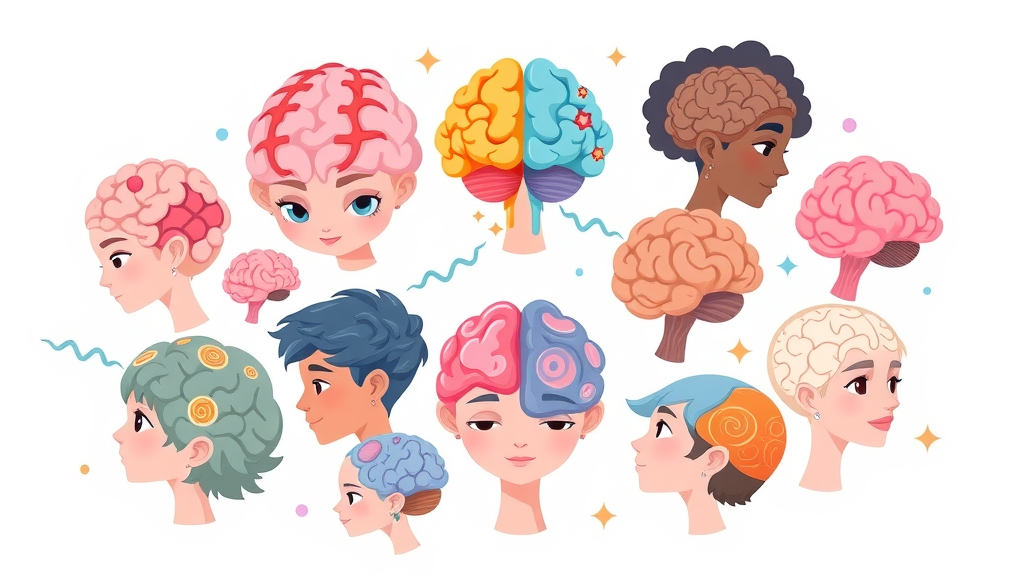Did you know that nearly 20% of Australians are neurodivergent , yet only a small fraction of businesses actively support neurodiversity in the workplace? This gap represents not just a missed opportunity for inclusion, but an untapped source of competitive advantage for forward-thinking companies. As Australian organisations face rapid change and complex challenges, those that welcome neurodivergent employees stand to outperform their peers in innovation, resilience, and overall results. In this guide, you'll discover the plain-English facts, real-world success stories, and actionable strategies that make neurodiversity in the workplace the secret weapon for both profit and purpose in modern Australia.
Neurodiversity in the Workplace: Surprising Facts Every Australian Business Should Know
- A recent study showed that nearly 20% of Australians are neurodivergent, yet only a fraction of businesses actively support neurodiversity in the workplace.

Unlocking Competitive Advantage: My Perspective on Neurodiversity in the Workplace
- Gain actionable insights into fostering an inclusive workplace.
- Learn practical ways to identify and support neurodivergent employees.
- Discover how neurodiversity at work is transforming leading Australian organisations.
When I first encountered the concept of neurodiversity in the workplace , it was through a tech company hiring autistic people not just to tick boxes, but to genuinely reshape processes, enhance creative problem solving, and transform team dynamics. Since then, I have seen firsthand how embracing neurodiversity is more than a “nice to have”—it’s a strategic imperative. Australian companies that tap into this overlooked talent pool are securing a competitive advantage that’s hard to replicate. Through intentional, inclusive work practices, these businesses spark fresh ideas, increase their collective brainpower, and build cultures where all team members thrive. In the sections that follow, I’ll share stories, data, and clear steps you can use to make neurodiversity at work a real, measurable benefit—no jargon required.
Understanding Neurodiversity in the Workplace: A Plain-English Introduction
What is Neurodiversity and Who Are Neurodivergent Employees?
- Definition of neurodiversity at work
- Common neurodivergent conditions: autism, ADHD, dyslexia, and more

At its core, neurodiversity in the workplace refers to the natural variation in how people’s brains process information, interact socially, and approach tasks. Neurodivergent employees include autistic people , those with attention deficit hyperactivity disorder (ADHD) , dyslexia, dyspraxia, Tourette’s syndrome, and other differences. Rather than being seen as deficits, these distinctions represent alternative ways of thinking and problem-solving that enhance organisational diversity of thought . For example, autism spectrum disorder (ASD) is often associated with exceptional attention to detail and pattern recognition, while those with dyslexia may excel in big-picture, creative tasks. Recognising and celebrating neurodivergent workers , rather than trying to “fix” or mask their differences, creates the foundation for a truly inclusive workplace .
Many job candidates may not disclose their neurological differences during the hiring process , fearing misunderstanding or discrimination. However, businesses that highlight their commitment to inclusive work become magnets for talent—especially people who previously felt excluded from traditional workplace norms. Creating clear definitions, sharing resources, and providing targeted accommodations helps neurodiverse people and neurodivergent employees alike realise their full potential at work.
Why Mental Health and Neurodiversity in the Workplace are Connected
- The overlap between mental health and neurodiversity in the workplace
- Reducing stigma in inclusive workplaces
There is a critical intersection between mental health and neurodiversity in the workplace. While neurodivergent conditions like autism or ADHD are brain-based variations, ongoing misunderstandings and social exclusion can cause anxiety, depression, and even burnout for those affected. By fostering an inclusive workplace environment where differences are celebrated, employers reduce not only the stigma but also the barriers to full participation and engagement.
Inclusive work addresses issues such as executive function challenges or communication preferences, making it easier for neurodivergent people to contribute authentically—without hiding their identities. Consistent support, peer networks, and mental health initiatives reinforce that neurodivergent employees are valued for who they are, not just what they produce. This holistic perspective transforms workplaces and improves well-being across the board.
Why Neurodiversity in the Workplace Gives a Competitive Advantage
- Australian companies outperform peers by supporting neurodivergent employees
- Innovation, problem-solving and improved team performance
- Case studies from local leaders
Australian businesses that actively support neurodiversity in the workplace consistently report stronger performance across key metrics—think innovation, improved problem-solving , and even higher profits. A ground-breaking Harvard Business Review piece highlighted that companies committed to hiring and nurturing neurodivergent employees saw measurable boosts in creativity, revenue growth, and customer satisfaction. Local examples abound: one Australian financial services firm credits its spike in client solutions to the hiring of neurodivergent workers specialising in pattern recognition, while a national tech leader reduced error rates by 40% using a neurodiverse software testing team.
“Embracing neurodiversity in the workplace is not a feel-good gesture—it’s a strategic imperative for outperforming the competition.”
Unlocking these gains requires intentional effort: cultivating diverse teams, building feedback-friendly cultures, and tailoring roles to different strengths. As more companies see the competitive advantage of neurodiversity, it becomes clear: supporting authentic diversity of thought isn’t just the right thing to do, it’s also a catalyst for sustainable business growth.
How Inclusive Work Benefits All: The Business Case for Neurodiversity in the Workplace
- Increased staff retention and satisfaction
- Better mental health outcomes
- 365% ROI: The numbers behind neurodiversity at work

Evidence shows that inclusive workplace policies that embrace neurodiversity at work deliver profound organisational benefits. Staff retention jumps as neurodivergent people feel valued and empowered. Team satisfaction and productivity rise, especially as diverse perspectives foster a sense of belonging and collective purpose. Most impressively, a study by Diversity Council Australia found that companies making these investments enjoy a 365% return on investment compared to those that do not.
| Companies with Neurodiversity Programs | Companies without Neurodiversity Programs | |
|---|---|---|
| Employee Engagement | +33% | -7% |
| Absenteeism | -27% | +11% |
| Productivity | +29% | -3% |
| Innovation Metrics | Significantly Higher | Limited or Declining |
With tangible improvements in mental health , reduced absenteeism, and increased team members’ loyalty and morale, the case for neurodiversity in the workplace writes itself. Put simply, inclusive work practices don’t just benefit neurodivergent workers—they make every employee and the business as a whole more resilient, adaptable and successful.
Building an Inclusive Workplace: Practical Steps for Supporting Neurodivergent Employees
What Inclusive Work Looks Like in Australian Offices
- Flexible policies and physical spaces
- Tailored training and accessible communication
- Leadership commitment to neurodiversity in the workplace

True inclusive work is visible from the moment you walk into an organisation. Quiet areas and flexible workspaces allow neurodivergent employees to manage sensory sensitivities. Inclusive technology—like screen readers or noise-cancelling headphones—is available for team members who benefit from additional resources. Beyond the physical, clear and varied communication (think written instructions paired with visual aids) gives all employees— neurotypical or neurodiverse —equal access to vital information.
Leadership plays a crucial role: public commitments, visible champions, and transparent policies on neurodiversity in the workplace set the tone for everyone. Australian offices succeeding in this area prioritise regular mental health check-ins, disability awareness training, and open forums for peers to exchange insights. In these environments, neurodivergent workers feel safe disclosing their needs, while managers become more adept at harnessing every individual’s strengths.
Supporting Neurodivergent Workers: What’s Required Beyond Compliance
- Practical adjustments for neurodivergent employees
- How managers can offer effective coaching
- Creating peer support and resources
Inclusive work doesn’t stop at complying with legal standards. Making a meaningful difference means going beyond accommodations. This might involve offering flexible hours , altered lighting, or customising task lists to suit a person’s unique skills. For example, someone with autism spectrum disorder may prefer written updates, while an employee with ADHD may excel in highly focused project work with regular feedback. Managers are pivotal—they should be trained to recognise neurodivergent traits, provide strengths-based coaching, and promote mutual respect within teams .
Creating peer support networks —like employee-led neurodiversity resource groups—and openly sharing guidance on mental health issues further reinforce a supportive culture. Australian organisations leading in neurodiversity inclusion also partner with disability employment services to assist with recruitment, onboarding and ongoing professional development for neurodivergent job candidates .

Hear direct accounts from diverse neurodivergent employees thriving in Australian offices. These stories showcase how everyday adjustments, understanding teams, and committed leadership drive extraordinary contributions. By embracing neurodiversity at work , employers unlock the full spectrum of human potential and foster workplaces built on respect, collaboration, and innovation.
These testimonials bring to life the themes discussed throughout this guide, reminding us that every step towards inclusion matters—both for individuals and for the future of work in Australia.
This video provides practical strategies from leading professionals and neurodivergent advocates. Learn how tailored adjustments, regular feedback, and accessible workplace technologies create enabling environments. Discover proven tools and coaching methods to empower neurodivergent employees across all levels of your organisation.
Expert advice addresses common barriers faced in recruitment, team integration, and ongoing development. These approaches go beyond compliance to foster genuine belonging and harness the unique strengths neurodivergent workers offer.
Managers are the linchpin of inclusive workplaces . In this video, learn actionable leadership tips to design processes, run meetings, and create team cultures that proactively support neurodiversity. Tools include flexible task allocation, clear multi-format communication, and processes for honest feedback from neurodivergent employees.
The video also covers successful case studies from Australian businesses who have seen marked improvements in innovation and staff retention through neurodiversity programs. Empower your managers to become true champions of neurodiversity in the workplace .
People Also Ask: What are examples of neurodiversity in the workplace?
- Examples include employees with autism, ADHD, dyslexia, dyspraxia, and other neurological differences. These individuals may contribute unique skills in pattern recognition, creative problem solving, and attention to detail, enhancing the organisation’s overall capabilities.
In practice, neurodiversity in the workplace means seeing team members who have autism spectrum disorder excelling in roles requiring accuracy, focus, and system thinking; employees with ADHD contributing bold creativity or rapid problem solving; and those with dyslexia offering out-of-the-box ideas in product design. Celebrating these examples amplifies the strengths that different ways of thinking bring to complex business challenges, especially during innovation or organisational change.
People Also Ask: How to manage neurodiverse employees?
- Effective management of neurodiverse employees involves clear communication, flexible work arrangements, and ongoing support. Training for managers and an open-door policy are also essential for a successful inclusive workplace.
Managing neurodivergent employees starts with empathy and individualized supports. Offer multiple methods for feedback, embrace flexible work arrangements , and provide continuous upskilling for all team leaders. Clear written instructions, open-door management, and access to supportive technologies ensure every neurodivergent worker can fully participate, regardless of their neurological conditions .
People Also Ask: What classifies you as neurodivergent?
- A person is considered neurodivergent if their brain operates differently from what is considered typical or neurotypical. This includes conditions such as autism, ADHD, dyslexia, Tourette syndrome, and others. These differences are not deficits but variations in human neurocognitive functioning.
The term neurodivergent is an umbrella for people whose neurological patterns differ in areas such as learning, attention, social interaction, communication, or executive function . Far from being defects, these neurodivergent individuals simply process the world in alternative, often uniquely valuable, ways.
People Also Ask: Can I ask an employee if they are neurodivergent?
- Employers must respect privacy and adhere to Australian anti-discrimination laws. You cannot directly ask if an employee is neurodivergent, but you can foster an environment where all staff feel comfortable seeking support if needed.
It’s both against best practice and, often, the law to directly ask about neurodivergence. Instead, employers should focus on building an inclusive workplace that makes it safe for all staff to request reasonable adjustments without fear of stigma or discrimination. Respect for privacy alongside a visible commitment to equity is key.
Steps for Creating a Truly Inclusive Workplace: Actionable Tips for Australian Businesses
- Review job descriptions and hiring processes for bias
- Implement flexible work options and supportive technologies
- Regularly update workplace mental health training
- Encourage employee-led neurodiversity resource groups
- Celebrate neurodiversity awareness events company-wide
"A genuinely inclusive workplace isn’t just a good business move—it’s a moral one."
Australian businesses can begin by reviewing every stage of the hiring process , ensuring job descriptions are written to attract—not inadvertently exclude—neurodivergent job candidates. Flexible work systems, mental health programs, and celebration of neurodiversity awareness events help create ongoing momentum for culture change. Most importantly, involve neurodivergent people directly in designing, leading, and evaluating these initiatives to ensure they meet real needs.
Tools like employee resource groups, accessible technologies, and frequent staff feedback drive sustainable progress, making neurodiversity in the workplace a lived reality—not just a policy statement.
Common Myths and FAQs About Neurodiversity in the Workplace
- Myth: Neurodivergent employees are less productive — Reality: Many outperform their neurotypical peers in key roles.
- Myth: Making accommodations is expensive — Reality: Most require minimal or no cost.
- FAQ: Can implementing neurodiversity policies increase workplace harmony?
- FAQ: Do Australian anti-discrimination laws protect neurodivergent workers?
Despite growing evidence, several myths still circulate around neurodiversity in the workplace . Contrary to popular misconceptions, neurodivergent workers often excel in detail-oriented, analytical, or creative tasks, directly contributing to business review outcomes. Adjustments like flexible hours or noise-reducing headphones are cheap, effective, and benefit many neurotypical team members. For better harmony and culture, visible commitment to neuroinclusion and compliance with Australia’s robust anti-discrimination laws are non-negotiables. Cultivating inclusive workplaces unlocks harmony, productivity, and business growth.
FAQs:
-
Can implementing neurodiversity policies increase workplace harmony?
Absolutely. By addressing individual needs and building respect for all ways of thinking , inclusive organisations report higher morale, lower turnover, and smoother teamwork. -
Do Australian anti-discrimination laws protect neurodivergent workers?
Yes. Employees with neurodivergent conditions are protected under the Disability Discrimination Act and other legislation. Employers are required to make reasonable adjustments unless it causes unjustifiable hardship.
Key Takeaways for Supporting Neurodiversity in the Workplace
- Neurodiversity in the workplace provides a measurable competitive advantage
- Australian businesses must lead by example in embracing neurodivergent employees
- An inclusive workplace is a wellbeing multiplier: for staff, culture, and bottom line
Empower your organisation to become a leader in neurodiversity at work . Take proactive steps and champion true inclusive work practices—your staff, and your bottom line, will thank you.
Ready to Build a Neurodiverse Workforce? Start Now
- Contact us here to arrange live training for your organisation, or start our online neurodiversity course for only $45 incl GST.
Sources
- https://hbr.org/2017/05/neurodiversity-as-a-competitive-advantage – Harvard Business Review
- https://www.dca.org.au/research/project/neurodiversity-workplace – Diversity Council Australia
- https://www.aihw.gov.au/reports/australias-health/neurodiversity-in-australia – Australian Institute of Health and Welfare
- https://www.sbs.com.au/news/article/workplaces-missing-out-on-talent-because-they-dont-hire-neurodivergent-people/uukh2vu24 – SBS News
 Add Row
Add Row  Add
Add 



Write A Comment